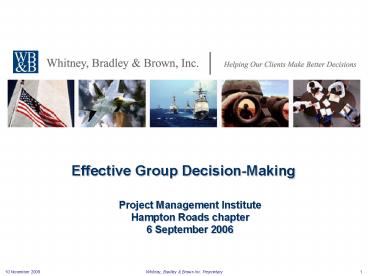Effective Group DecisionMaking - PowerPoint PPT Presentation
1 / 26
Title:
Effective Group DecisionMaking
Description:
Some problems are so complex that no one person has all the experience, insight, ... Energizing people to achieve high levels of performance and overcome barriers to ... – PowerPoint PPT presentation
Number of Views:32
Avg rating:3.0/5.0
Title: Effective Group DecisionMaking
1
Effective Group Decision-Making
Project Management InstituteHampton Roads
chapter6 September 2006
2
Ahthe joys of decision making!
Project Stakeholders
You?
3
Overview
- Why teams?
- The trouble with teams
- Decision-making in the PMBOK
- The true nature of decisions
- What constitutes a good decision?
- Tools
- Process
- GroupSystems examples
4
Why Teams?
Two people can accomplish more than twice as
much as one they get a better return for their
labor. - Ecclesiastes 49
- Some problems are so complex that no one person
has all the experience, insight, knowledge, or
resources needed to solve the problem single
handedly
- All teams and organizations exist to create value
that individual members cannot create on their own
5
The trouble with teamwork
6
Decision-making in the PMBOK
Decision Tree Analysis
7
The true nature of decisions
- Although we often refer to objective
decision-making, the reality is that all
decisions are subjective. - All decisions are influenced by values.
- Since all decisions have more than one objective,
the relative importance of objectives will
influence the choice of the best alternative.
The determination of relative importance is
subjective therefore, in actuality all decisions
are subjective. - Saaty Objectivity is nothing more than agreed
upon subjectivity. - The good new is, Decision-making skills can be
taught
- Not a magic formula that finds the right
answer - Rather, it is a process that helps
decision-makers make a decision that best
achieves the multitude of their objectives.
8
What constitutes a good decision?
- A rational decision is one that best achieves the
multitude of objectives of the decision-makers
(notice multitude of objectives). - Includes hard data and includes judgment of
subject matter experts (SMEs) - Capture the quality judgment of SMEs with a
defensible process
- Good decision-making is not a magic formula that
finds the right answer. - Good decision-making is a process that helps
decision-makers make a decision that best
achieves the multitude of their objectives.
9
What Do Successful Teams Use? Tools
- A process that includes
- A clearly thought out agenda, and
- Facilitation by trained facilitator, and
- Satisfactory documentation
Teams need TOOLS and a PROCESS to bring about an
end or result
10
What Do Successful Teams Do? Process
- Successful group collaboration includes these
actions - Generate ideas
- Converge ideas
- Organize ideas
- Evaluate ideas
- Build Consensus
Teams need TOOLS and a PROCESS to bring about an
end or result
11
One Example GroupSystems
- Control of agenda and agendees
- Control movement in and out of supporting tasks
- Contribute simultaneously
- Ideas from everybody and all voices heard less
clutter - Generate evaluate ideas anonymously, on merits
(or, if preferred, with attribution) - Unconventional / unpopular ideas get attention
- Create useful patterns of collaboration
- Predictable, repeatable success --- paper trail
- Digital Archives
- Complete set of records of the group activities
12
Define Agenda
13
Leader Controls Participation including Start
and Stop of the activity
14
Brainstorm Categorize Ideas
15
Capture Comments Verbatim
16
Sort Prioritize Ideas
17
Quick Votes
18
Sliding Scales
19
Scale of Agreement
20
Whiteboard Capability
21
Auto-complied Documentation
22
Review
- Why teams? Too few Jeffersons
- Teams wrought with dangerand opportunity!
- Decision-making is in the PMBOK
- The true nature of decisions
- Result of a process
- Subjective
- What constitutes a good decision?
- Best meets objectives
- Good news, tools processes can help
- The means to better decisions can be learned!
- Tools Process both necessary
- Electronic tools can help
- Example, GroupSystems
23
You get the picture
- For the best output, proper tools and proper
process are needed.
24
PMI eSeminarsWorld
Building Teams, Commitment and Culture for
Virtual TeamsDate 28 September-14
OctoberRegistration Deadline 27
SeptemberPriceMember- 895.00 USNon-Member-
995.00 USPDUs 14Contact Hours 14 Human
Factors and Team Dynamics for Project
ManagersSuccessful Project Managers must be
well equipped to overcome the challenges posed by
the human factors and interpersonal dynamics of
the project team. This course will explore the
intricacies of working in a team environment. You
will learn concepts and techniques that have an
immediate impact upon your ability to communicate
effectively, create rapport, resolve conflict,
lead team members and motivate project
stakeholders. The course features techniques for
dealing with difficult people and easy-to-use
skills to increase the performance of a project
team.
25
References
- Janis, I. L. (1989). Crucial decisions
Leadership in policymaking and crisis management.
New York Free Press - Kepner, C. H. and Tregoe, B. B. (1965). The
rational manager A systematic approach to
problem solving and decision-making. New York
McGraw Hill - Russo, E. J. and Shoemaker, P. J. H. (1989).
Decision Traps. New York Doubleday - Bazerman, M. (1986). Judgment in managerial
decision making. New York John Wiley Sons.
26
- Thank you!































